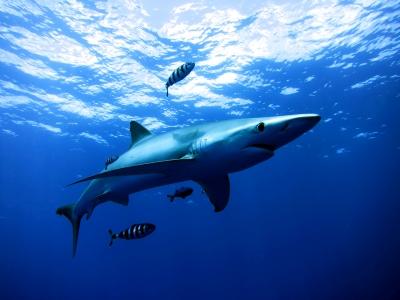BackgroundThe Mediterranean blue shark (Prionace glauca) population has been categorized by IUCN as "vulnerable" and, according to Ferretti et al. (2008), blue shark (BS) populations have been subjected to a 96% decline in abundance and 99% in biomass over the last 50 years. Tagging studies outside the Mediterranean demonstrated extensive individual movements, considering BS among the most high-migratory shark species. BS distribution in the Mediterranean Sea is significantly related to environmental cues with a strong longitudinal constituent in the presence of BS (the probability increasing from east to west). So far genetic studies carried out in the world oceans revealed an interoceanic genetic structuring with gene-flow generally restricted within ocean. The connectivity of the Mediterranean BS with the global populations still remains unclear since there are no data from tagging and/or genetic studies. Conservation and management of this resource requires a deeper knowledge in order to promote appropriate conservation policies. |
Project objectivesThe main idea behind this initiative is to contribute new unprecedented knowledge on BS by creating a robust baseline of data describing the genetic stratification of BS in the Mediterranean. The approach would shed light on aspects related to their population structure, the connection to non-Mediterranean populations, and help to design management schemes in order to strengthen conservation efforts for BS. The key objective is to scrutinize the prevailing assumption that Mediterranean BS form only one population, or one "stock". As outlined above meeting this objective will provide a scientific basis for managing the stock(s). Obviously, the findings will be of use to all scientific and management bodies (ICCAT, GFCM/FAO, IUC, ICES, STECF), in that they will help to tailor current management schemes through the assessment of the true status of the stock(s) and also to revise and enhance conservation measures. The tendered MedBlueSGen project aims to:
|
PartnersThe contractors team The Alma Mater Studiorum - University of Bologna (UNIBO) - Leading Partner -, is the oldest University in the World being born in 1188 A.D. The Department of Biological, Geological and Environmental Sciences (BiGeA) is the UNIBO research structure leading initiatives in the scientific fields of marine fisheries and conservation. The National and Kapodistrian University of Athens (NKUA), officially founded in 1837, is the first University in the Eastern Mediterranean region. The Department of Zoology-Marine Biology, which includes the laboratory of Ichthyology is dedicated to the research of marine resources with a specialization in large pelagics. The University of Padova (UNIPD) is the second oldest university in Europe. The Department of Comparative Biomedicine and Food Science (BCA) of UNIPD has a long experience in research on genetics and genomics of marine species, especially fish and shellfish. The group has also a very successful record of participation in EU funded projects. The Institute Español de Oceanografia (IEO) was founded in 1914 and is devoted to the scientific knowledge of the oceans and the sustainable use of its fishing resources and the marine environment. The IEO has 9 research centres, a core of circa 450 permanent staff and a fleet of 6 research vessels. The University of Calabria (UNICAL) is the biggest University in the region. The Department of Biology, Ecology and Earth Sciences (DiBEST) is the UNICAL's research structure leading initiatives in the scientific fields of marine biology and conservation. Queen's University Belfast (QUEEN'S) with over one hundred active researchers, the School of Biological Sciences comprises two main research groups: Ecology, Evolution, Behaviour and Environmental Economics (EEBEE) and Molecular Biosciences (MB). Within the School, the Fish Genetics and Molecular Ecology Laboratory (FGMEL) has a strong international reputation in genetics research, which is primarily focused on the areas of biodiversity, population and conservation genetics, and aquaculture of finfish and shellfish. University of Genova (UNIGE). The Department of Earth, Environment and Life Sciences (DiSTAV) was born from the desire to merge into a single structure different disciplines and cultural areas, aimed to implement the knowledge of the marine ecosystems, harmonizing requirements for conservation and sustainable exploitation of marine resources. The Joint Research Center team The mission of the Joint Research Centre (JRC) is to provide customer-driven scientific and technical support for the conception, development, implementation and monitoring of EU policies. Close to the policy-making process, it serves the common interest of the Member States, while being independent of special interests, whether private or national. JRC began work in fisheries in 1999 and assumed the secretariat of the Scientific, Technical and Economic Committee to Fisheries at the beginning of 2005, being responsible for checking the quality of data for use by the scientists of that Committee. Since 2006 it is coordinating the assessment of the economic performance of European fleets using data from the Data Collection Regulation. |

